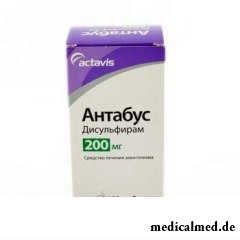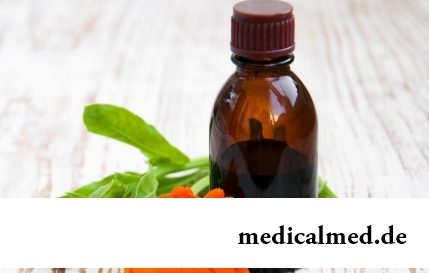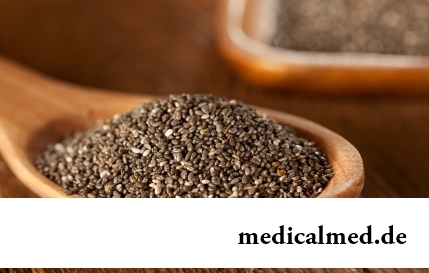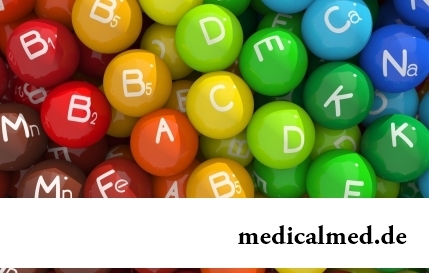





Antabusum
Application instruction:
 Antabusum – the drug causing the following negative effects in combination with alcohol: nausea, vomiting, "inflows" of blood to the person, tachycardia, hypotonia, etc.; alcohol intake after its reception is extremely unpleasant that creates conditioned-reflex disgust for a smell and taste of alcoholic drinks.
Antabusum – the drug causing the following negative effects in combination with alcohol: nausea, vomiting, "inflows" of blood to the person, tachycardia, hypotonia, etc.; alcohol intake after its reception is extremely unpleasant that creates conditioned-reflex disgust for a smell and taste of alcoholic drinks.
Form of release and structure
Dosage form of Antabusum – a tablet sparkling: almost white or white color, round, flat, with slanted edges:
- dose of 0,2 g: one of the parties is divided risky with marking by "CD" | on each side "With" (on 100 pieces in containers from polyethylene of high density / bottles of dark glass with a polyethylene cover, 1 container/bottle in a cardboard pack);
- dose of 0,4 g: on one of the parties crosswise risk, dividing a tablet into four equal parts, and marking of "CJ" (on 50 pieces in containers from polyethylene of high density / bottles of dark glass with a polyethylene cover, 1 container/bottle in a cardboard pack).
Sparkling contain in 1 tablet:
- active ingredient: Disulfiramum – 0,2 g or 0,4 g;
- auxiliary components: povidone, starch corn, tartaric acid, talc, magnesium stearate, Natrii hydrocarbonas, silicon dioxide colloid, cellulose microcrystallic.
Indications to use
Drug is shown for therapy and prevention of a recurrence of an alcoholism.
Contraindications
Absolute:
- heavy pathologies of cardiovascular system, including noncompensated heart failure and disturbances of coronary circulation, such as arterial hypertension, coronary heart disease;
- crushing organic lesions of a brain, anamnestic data on the had stroke;
- renal failure of heavy degree;
- psychological frustration, including psychoses, risks of suicide attempts, severe forms of the pathologies relating to frustration of the personality;
- heavy abnormal liver functions with exceeding of the upper bound of standard of activity of microsomal liver enzymes by 3 times and more, data in the anamnesis on side reactions from a liver at the previous therapy by Disulfiramum;
- drunkenness or the use of the medicines or drinks containing ethanol for 24 hours before administration of drug;
- syndrome of medicinal dependence;
- the period of pregnancy and lactation (there are not enough data on safety and efficiency of use of Antabusum for this category of patients);
- children's and teenage age up to 18 years (there are no data on safety and efficiency of use);
- hypersensitivity to Disulfiramum or auxiliary components of drug.
Relative: Antabusum is applied with care at a diabetes mellitus, a hypothyroidism, signs of an irreversible damage of a brain, a renal failure, diseases of respiratory system or a liver, epilepsy or a convulsive syndrome of any genesis (the probability Disulfiramum - ethanol reaction in heavier degree), peripheral neuropathy, a peptic ulcer of a stomach and a 12-perstny gut, an optic neuritis, and also at advanced age (after 60 years is increased).
Route of administration and dosage
The sparkling pill Antabusum is taken inside, previously having dissolved in water (1/2 glasses).
Drug is used only under observation of the doctor. Therapy is appointed after careful clinical inspection of the patient and the warning of abstention from alcohol intake for the period of treatment, and also possible complications and effects.
Drug is accepted according to the individual scheme determined by the attending physician at the rate of 0,2-0,5 g by 1-2 times a day.
7-10 days later from the beginning of therapy it is necessary to carry out Disulfiramum - alcoholic test. For this purpose the patient is given 20-30 ml of vodka after reception of 0,5 g of drug if reaction weak, the dose of alcohol is increased to 30-50 ml (the most admissible dose of vodka – 100-120 ml). In 1-2 days test is repeated in the conditions of a hospital, after 3-5 days – it is out-patient, as necessary adjust doses of alcohol and/or drug. Further Antabusum is allowed to use in a maintenance dose 0,15-0,2 g/days for 1-3 years.
Side effects
Nonspecific side effects, the most often observable at reception of Antabusum which, including, can be connected with a basic disease: a headache, drowsiness, reactions from the digestive tract (DT). At their manifestation, perhaps, it will be required to reduce a drug dose.
Frequency of undesirable reactions from bodies and systems (according to the following classification –> 1/10 – it is very frequent,> 1/100-<1/10 – often,> 1/1000-<1/100 – infrequently,> 1/10 000-<1/1000 – seldom, <1/10 000, including isolated cases – it is very rare, frequency is unknown):
- GIT: often – pain in epigastriums, nausea, vomiting, diarrhea, metal smack in a mouth, an unpleasant smell from a mouth; frequency is unknown – the unpleasant smell at patients with colostomy caused by availability of carbon sulfide;
- gepatobiliarny system: often – increase in activity of liver enzymes (gamma глутамилтрансферазы and transaminases); seldom – jaundice; very seldom – clinical symptoms of a hepatotoxic, defeat of cells of a liver, hepatitis, fulminantny hepatitis owing to an extensive necrosis of a liver which result can become a liver failure a hepatic coma and a lethal outcome (these side effects usually arise within the first 8 weeks of therapy and are not dozozavisimy);
- immune system: infrequently – allergic reactions;
- data of laboratory and tool researches: seldom – deviations of results of functional tests of a liver from normal indicators, in t. h increase in blood of concentration of bilirubin and growth of activity of aspartate aminotransferase (nuclear heating plant) and alaninaminotranspherase (ALT);
- nervous system: often – a food faddism, drowsiness, a headache; seldom – polyneuropathy, peripheral neuropathy, an optic neuritis (smokers are most predisposed to its development), a tremor, encephalopathy; very seldom – confusion of consciousness, a spasm, neurologic disturbances (most likely dozozavisima, arise usually several months later from an initiation of treatment, are slowly reversible);
- mentality: often – manias, a depression; seldom – psychotic reactions (schizophrenia, paranoia) (such frustration arise preferential at patients with schizophrenia or a depression in the anamnesis, they are connected probably with increase in level of a dopamine as a result of inhibition допамин-β-гидроксилазы Disulfiramum); very seldom – an acute organic brain syndrome, behavior disorders;
- generative organs and mammary gland: infrequently – sexual dysfunction, decrease in a libido;
- skin and hypodermic cellulose: infrequently – allergic dermatitis, an acne, a skin itch, rash;
- other reactions: often – a subjective sensation of discomfort, a somnolence, fatigue.
The side reactions which are possibly arising owing to combined use of Disulfiramum and ethanol:
- cardiovascular system: heart consciousness, tachycardia, short wind, arrhythmias, dizziness, faint;
- GIT: vomiting;
- musculoskeletal system: muscular spasm;
- nervous system: headache, drowsiness, lack of coordination, loss of consciousness;
- mentality: apathy;
- skin and hypodermic cellulose: a hyperhidrosis, "inflows" of blood to the person;
- vessels: hypotonia, cardiovascular collapse;
- other reactions: fatigue.
Result of overdose of a combination ethanol Disulfiramum can be a cardiovascular collapse, consciousness oppression (up to a coma), neurologic complications. In such situation symptomatic therapy is carried out.
Special instructions
Patients are required to be warned about danger of reaction of intolerance of alcoholic beverages.
At co-administration of Antabusum with peroral anticoagulants more frequent control of maintenance of a prothrombin and correction of doses of anticoagulants is necessary, it is connected with the increased probability of development of bleeding.
Patients with a hypothyroidism or a renal failure take Disulfiramum with caution, especially at risk of its possible combination to alcohol.
The side reactions caused by reception of Disulfiramum (including fatigue and drowsiness), exert impact on speed of psychomotor reactions and ability to concentration of attention. In case of such states during therapy by the drug Antabusum from control of difficult mechanisms and vehicles, including the car, it is required to abstain.
Medicinal interaction
Ascorbic acid reduces reaction of Disulfiramum to ethanol.
Contraindicated combined use of Antabusum and alcohol (the alcoholic drinks and medicines containing alcohol) as it can cause the reactions of intolerance which are followed by blood "inflows", an erythema, vomiting, tachycardia.
Others the undesirable and demanding care combinations with Disulfiramum:
- isoniazid – the lack of coordination and behavior is possible;
- орнидазол, секнидазол, metronidazole, Tinidazolum (nitro-5-imidazoles) – can cause confusion of consciousness and delirious frustration;
- Phenytoinum – Disulfiramum suppresses his metabolism thereof there is a bystry and considerable rise in level of Phenytoinum in plasma which is followed by toxic symptoms;
- peroral anticoagulants (including warfarin) – their effect and danger of bleeding as a result of reduction of disintegration in a liver amplifies (it is required to carry out more frequent control of concentration and dose adjustment of anticoagulants, including for 8 days after cancellation of Disulfiramum);
- theophylline – correction of its dose towards decrease depending on concentration in plasma and clinical symptoms is necessary (because of inhibition theophylline metabolism Disulfiramum);
- benzodiazepines – Antabusum is capable to exponentiate their sedation by inhibition of oxidizing metabolism (in particular diazepam and chlordiazepoxide) that demands correction of a dosage according to a clinical picture;
- tricyclic antidepressants – there is a probability of strengthening of reaction of intolerance of ethanol, especially at the patients accepting alcohol against the background of therapy by Disulfiramum.
When above-mentioned combinations cannot be avoided, in the course of therapy and after treatment by Antabusum control of concentration of drug in plasma and regular clinical observation of patients is necessary.
Terms and storage conditions
To store at a temperature not above 30 °C. To protect from children.
Period of validity – 5 years.
Each person has not only unique fingerprints, but also language.

Season of activity of viral infections in the heat. Everyone can get sick, but probability of this unpleasant event it is possible and it is necessary miny...
Section: Articles about health
Cystitis, or inflammation of a mucous membrane of a bladder, this very widespread disease which, owing to some features of a structure of bodies of urinogenital system, women have approximately four times more often than men. In the main risk group...
Section: Articles about health
The cosmetics intended for improvement of a condition of skin, nails and hair are used by each woman. Expenses on regular acquisition of the fashionable widely advertized products of well-known companies for many become very notable and significantly burden the family budget. Meanwhile, there is a number of inexpensive pharmaceutical drugs which can quite be applied in the cosmetic purposes. At the same time the effect of their use is often more noticeable, than result of use of the most expensive...
Section: Articles about health
The endocrine system carries out in a human body extremely important role, practically all processes of life activity регулируютс...
Section: Articles about health
Aging — natural and inevitable process. Over time our skin loses elasticity, on it saggings are formed, the face form loses former clearness. The procedure of nitevy lifting (nitevy tightening) can successfully solve this problem. In order that it is better познако...
Section: Articles about health
The varicosity has familiarly many, statistically, this disease more than a half of all adult population. As a rule, the varicosis affects preferential superficial vessels, and is shown by characteristic cosmetic defects. The deep vein thrombosis as this illness at the initial stages can imperceptibly proceed is represented much more dangerous, and in the started cases threatens with serious danger – thrombosis. This state, when the blood clot formed...
Section: Articles about health
The pine is one of the most widespread plants of our woods. Its needles and pitch not without reason called by "gallipot", since ancient times испол...
Section: Articles about health
It is known that the person for 80% consists of water which participates in all processes of an organism. The person loses liquid daily – as a result of sweating, breath, an urination, and its insufficient completion due to various reasons can bring to обезвожив...
Section: Articles about health
Tea is loved and use almost everything. This drink has tonic properties, contains the tannins capable to suppress activity of causative organisms. Recently great popularity was gained by teas with vegetable additives. The medicative herbs, spices and fruit which are a part of such mixes enrich drink with vitamins and microelements, increasing its nutritional value and creating additional curative effect....
Section: Articles about health
More than a half of the married couples which faced prostatitis – leave. The new broadcast "Female View of Prostatitis" will help to learn...
Section: Articles about health
Any person who faced a disease knows that treatment costs expensive. It belongs also to consultations of qualified specialists, and to the diagnostic procedures which are not included in the list of obligatory medical services. Question of cost of medicinal Wednesday...
Section: Articles about health
When overcomes feeling of hunger, and an opportunity to have dinner fully is absent, having a snack − the meals, small on volume, stabilizing sugar level in blood comes to the rescue. The relation of nutritionists to having a snack more often negative, but only because as snack people choose the most caloric products with the increased amount of "bystry" carbohydrates: cookies, rolls, chips, candies. Nevertheless, the advantage of having a snack is obvious to weight loss: the person avoids strong feeling of hunger...
Section: Articles about health
The medicine promptly develops, and the fact that else quite recently it seemed by miracle can now. We are not surprised any more to the fact that sport...
Section: Articles about health
About influence of fasting days on an organism it is told much – both about advantages, and about shortcomings. It is considered that fasting day in the form of a short-term monodiet is useful, promoting effective removal of slags from an organism whereas irregular, it is excessive п...
Section: Articles about health
The nature does not stand stagnation and monotony. It is known that tissues of a human body atrophy if do not receive necessary loadings. It fully belongs also to a cerebral cortex: when it is not given full-time job, it begins to function worse. As a result memory decreases, the person becomes less bright, acquires information more slowly, hardly switches from one thought to another. There are problems at work, difficulties with communication and career development. These it is unpleasant...
Section: Articles about health
Such trouble as the milkwoman's attack, at least once in life happened almost to each woman. Prevalence забол...
Section: Articles about health
Radiological methods of a research are applied in medicine more than hundred years, and thanks to them millions of lives were saved. In many cases without X-ray it is impossible to make exact idea of a condition of bodies and fabrics, it is correct to make the diagnosis. Those...
Section: Articles about health
The way of life of people promptly changes from year to year: if about ten years ago the personal computer was not in each family, then today already very few people do without this device. Certainly, and children master the computer at full speed: they not only play on it games, but also study, and write school works, and search for necessary information....
Section: Articles about health
Producers of milk mixes for children assure: mixes are ideally balanced and adapted for needs of babies. In a sluch...
Section: Articles about health
Cellulitis - very widespread cosmetic shortcoming which arises approximately at 80% of women sooner or later. Emergence it is connected with change of structure of a hypodermic fatty layer. At the same time on the surface of skin at first there are roughnesses (cambers...
Section: Articles about health
Partial and the more so full loss of hearing significantly reduces quality of life. Difficulties with communication lead to loneliness and isolation. The person who badly hears experiences difficulties with social and professional implementation, quite often has problems in private life....
Section: Articles about health
The unpleasant feelings connected with spring breakdown are familiar almost to each of us. Often happens that in March-April on the person...
Section: Articles about health
Work of a brain is extremely complex and in many respects is not studied yet. It is confirmed also by the features of thought processes which are shown when the person sleeps. Let's tell about some of them....
Section: Articles about health
Ability of an organism to resist to adverse environmental factors (to impact of temperature drops, humidity and pressure, to the attacks of causative organisms, etc.) directly depends on what the person eats. Business here not only in that cells of a body received a necessary set of nutrients, vitamins and microelements. Scientists established that such components which are capable to influence negatively immune system, in connection with also are a part of foodstuff...
Section: Articles about health
According to data of World Health Organization, the cataract is diagnosed almost for 7% of the population of Earth. Statistics we get sick...
Section: Articles about health
The chia plant, or the Spanish sage, is from South America. The indigenous people of the continent since ancient times used its seeds in food: small, but very nutritious kernels, in a form the reminding fasolina. Indians knew about useful properties of seeds of a chia, and applied...
Section: Articles about health
80% of women at least once to lives complained of discomfortable feelings to breasts, consolidations and nagrubaniye. These are mastopathy symptoms. The mastopathy is characterized by change of a ratio between ferruterous and connective tissue tissues of mammary glands. It can lead to formation of cysts (a cystous mastopathy), gland consolidation (a fibrous mastopathy), or a combination of these processes (a fibrous and cystous mastopathy)....
Section: Articles about health
